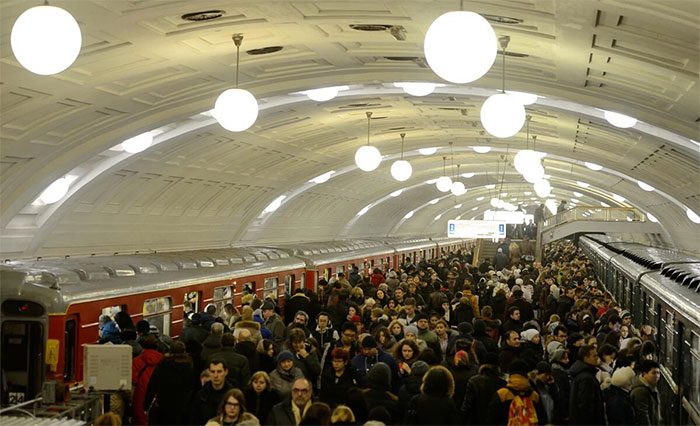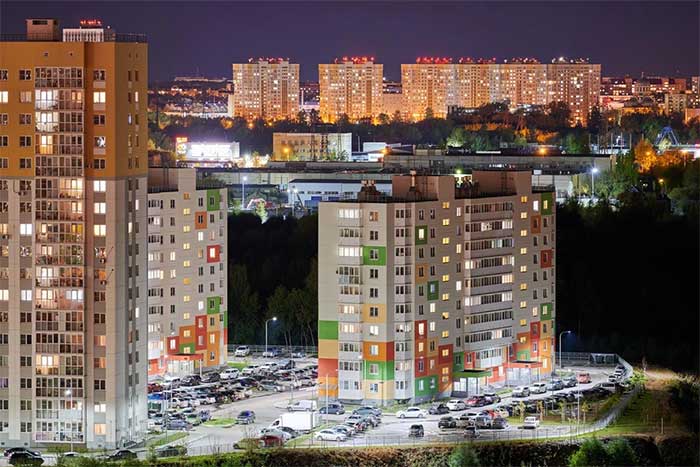According to Russia Beyond (RBTH), Russia ranks fourth in the world for the number of cities with populations over 1 million, following China, India, and Brazil. The latest data from the United Nations indicates that Russia currently has a population of nearly 146 million people, accounting for 1.82% of the global population, and placing it ninth in the world rankings of countries and territories by population.
With a total land area of 16,299,981 km2, 74.93% of the population lives in urban areas (109,346,052 people as of 2019). The level of urbanization in this country has consistently remained above 70% for many decades.
Why Do Residents of the World’s Largest Country Prefer Living in Big Cities?

A residential area in Moscow.
Most of Russia’s cities with populations over one million are the result of a specific government strategy aimed at granting these cities special status and attracting more funding. This means they offer higher quality education, housing, and healthcare compared to other regions.
Climate issues also play a significant role in why people flock to large cities in this country. In winter, when the weather becomes harsher than ever, residing in big cities provides greater convenience for commuting. Consequently, subways are only built in 13 of Russia’s major cities, leading people to congregate in these areas for easier access to work.
Additionally, large cities have more public transportation options, making travel on the roads safer under severe weather conditions.

Moscow Subway.
Moreover, these large cities boast numerous shopping malls, cafes, and entertainment centers with warm areas. Here, people can enjoy leisure time with friends or family even when the weather turns bad. Big cities also attract business and investment, leading to more job opportunities and drawing a large workforce to live and work here.
In Moscow alone, over 12 million people reside, and when including residents from the surrounding Moscow region, that number rises to over 20 million.
Beyond the capital, more than 1 million people also live in the following cities: Saint Petersburg (5 million), Novosibirsk (1.6 million), Yekaterinburg (1.5 million), Kazan (1.3 million), Nizhny Novgorod (1.2 million), Chelyabinsk (1.2 million), Samara (1.1 million), Omsk (1.1 million), Rostov-on-Don (1.1 million), Ufa (1.1 million), Krasnoyarsk (1.1 million), Voronezh (1.1 million), Perm (1.1 million), and Volgograd (1 million).
From Rural to Urban

Nizhny Novgorod at night.
Aside from Moscow and Saint Petersburg, large cities in Russia only began to emerge around the early 20th century. According to the 1897 census, Moscow had about one million residents, while Saint Petersburg had 1.3 million. The next cities with populations exceeding one million only appeared in the late 1960s and included Gorky (now Nizhny Novgorod), Novosibirsk, Kuibyshev (now Samara), and Sverdlovsk (now Yekaterinburg).
The issue was that before the 1917 Revolution, only 15% of Russians lived in urban areas while the rest resided in rural areas and engaged in agriculture. This changed as the government promoted industrialization. In the 1920s, cities began to spring up around factories and mining sites across the country. These areas were designed not only to provide jobs and housing but also to offer residents engaging social and recreational activities.

A residential area in Yekaterinburg.
This rapid urbanization process did not even cease during World War II, during which more than 50 cities were established due to the evacuation of many factories from central Russia. The ultimate result of all this was that by the mid-20th century, many people had migrated to cities in search of better jobs, education, and living conditions.


















































